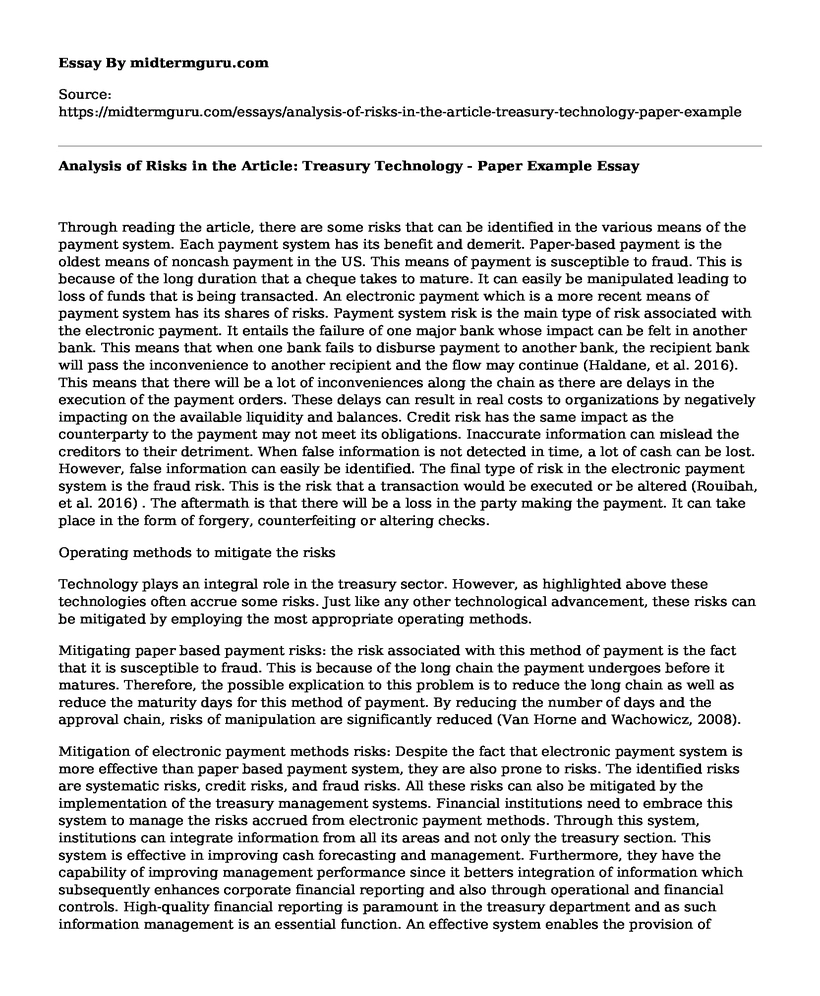Through reading the article, there are some risks that can be identified in the various means of the payment system. Each payment system has its benefit and demerit. Paper-based payment is the oldest means of noncash payment in the US. This means of payment is susceptible to fraud. This is because of the long duration that a cheque takes to mature. It can easily be manipulated leading to loss of funds that is being transacted. An electronic payment which is a more recent means of payment system has its shares of risks. Payment system risk is the main type of risk associated with the electronic payment. It entails the failure of one major bank whose impact can be felt in another bank. This means that when one bank fails to disburse payment to another bank, the recipient bank will pass the inconvenience to another recipient and the flow may continue (Haldane, et al. 2016). This means that there will be a lot of inconveniences along the chain as there are delays in the execution of the payment orders. These delays can result in real costs to organizations by negatively impacting on the available liquidity and balances. Credit risk has the same impact as the counterparty to the payment may not meet its obligations. Inaccurate information can mislead the creditors to their detriment. When false information is not detected in time, a lot of cash can be lost. However, false information can easily be identified. The final type of risk in the electronic payment system is the fraud risk. This is the risk that a transaction would be executed or be altered (Rouibah, et al. 2016) . The aftermath is that there will be a loss in the party making the payment. It can take place in the form of forgery, counterfeiting or altering checks.
Operating methods to mitigate the risks
Technology plays an integral role in the treasury sector. However, as highlighted above these technologies often accrue some risks. Just like any other technological advancement, these risks can be mitigated by employing the most appropriate operating methods.
Mitigating paper based payment risks: the risk associated with this method of payment is the fact that it is susceptible to fraud. This is because of the long chain the payment undergoes before it matures. Therefore, the possible explication to this problem is to reduce the long chain as well as reduce the maturity days for this method of payment. By reducing the number of days and the approval chain, risks of manipulation are significantly reduced (Van Horne and Wachowicz, 2008).
Mitigation of electronic payment methods risks: Despite the fact that electronic payment system is more effective than paper based payment system, they are also prone to risks. The identified risks are systematic risks, credit risks, and fraud risks. All these risks can also be mitigated by the implementation of the treasury management systems. Financial institutions need to embrace this system to manage the risks accrued from electronic payment methods. Through this system, institutions can integrate information from all its areas and not only the treasury section. This system is effective in improving cash forecasting and management. Furthermore, they have the capability of improving management performance since it betters integration of information which subsequently enhances corporate financial reporting and also through operational and financial controls. High-quality financial reporting is paramount in the treasury department and as such information management is an essential function. An effective system enables the provision of pertinent financial information. All these can be done by the treasury management system. Despite there being costs incurred in the purchase of the hardware and software of the system, it is worth the cost since the data obtained from the different internal and external sources enhances forecast accuracy as well as liquidity thus reducing the firms borrowing costs and fostering returns on investment of the available funds (Yohannes, 2007). Therefore, firms should consider the installation of this system to help in the mitigation of risks associated with the electronic payment systems.
Bibliography
Haldane, A.G., Millard, S. and Saporta, V., 2016. The Future of Payment Systems (Routledge International Studies in Money and Banking).
Rouibah, K., Lowry, P.B. and Hwang, Y., 2016. The effects of perceived enjoyment and perceived risks on trust formation and intentions to use online payment systems: New perspectives from an Arab country. Electronic Commerce Research and Applications, 19, pp.33-43.
Van Horne, J.C. and Wachowicz, J.M., 2008. Fundamentals of financial management. Pearson Education.
Yohannes, B.W., 2007. Treasury management: An African perspective. Journal of Corporate Treasury Management, 1(1).
Cite this page
Analysis of Risks in the Article: Treasury Technology - Paper Example. (2021, Jun 02). Retrieved from https://midtermguru.com/essays/analysis-of-risks-in-the-article-treasury-technology-paper-example
If you are the original author of this essay and no longer wish to have it published on the midtermguru.com website, please click below to request its removal:
- Accounts Payable Turnover Ratio for National Central Cooling Company
- Essay on Roles of Financial Institutions in Our Economy
- Benefits of Subprime Lending - Paper Example
- Critical Analysis of the Static Budget - Report Paper Example
- Essay on Madoff Ponzi Scheme
- Robots Are Better Than Human - Argumentative Essay
- Smartphones' Impact on Children's Mental Health - Essay Sample







